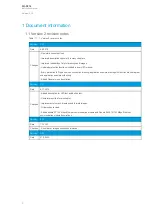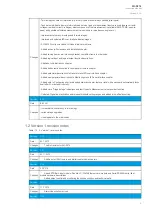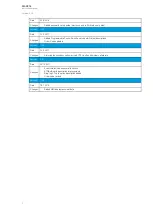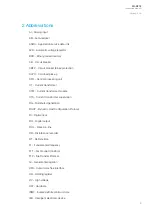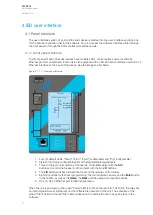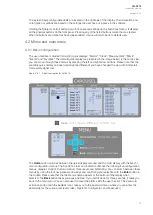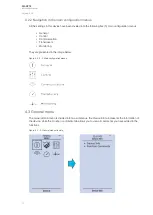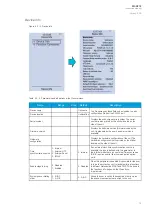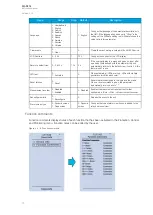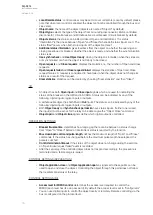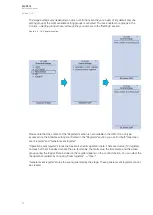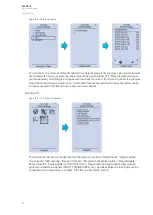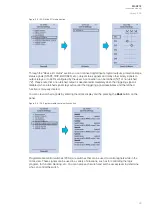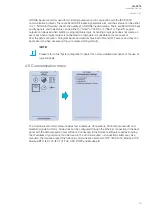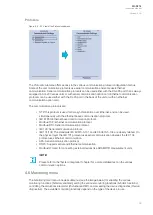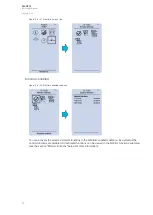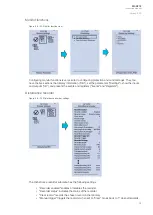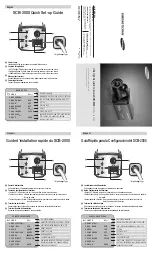
• LLoc
ocal/R
al/Remo
emotte sta
e stattus
us: control access may be set to Local or Remote (Local by default; please
note that when local control is enabled, the object cannot be controlled through the bus and
vice versa).
• Ob
Object name
ject name: the name of the object (objects are named "ObjectX" by default).
• Ob
Object t
ject type
ype: selects the type of the object from Grounding disconnector, Motor-controlled
disconnector, Circuit breaker and Withdrawable circuit breaker (Circuit breaker by default).
• Ob
Object x sta
ject x stattus
us: the status can be Bad, Closed, Open and Intermittent. The status
"Intermittent" is the phase between "Open" and "Closed" where both status inputs are 0. The
status "Bad" occurs when both status inputs of the object/cart are 1.
• A
Additional sta
dditional stattus inf
us informa
ormation
tion: gives feedback from the object on whether the opening and
closing are allowed or blocked, whether the object is ready, and whether the synchronization
status is ok.
• Use synchr
Use synchrocheck
ocheck and Use Ob
Use Object r
ject read
eadyy: closing the object is forbidden when the sides are
not synchronized or when the object is not ready to be closed.
• Open r
Open requests
equests and C
Close r
lose requests
equests: displays the statistics, i.e. the number of Open and Close
requests.
• Open r
Open requests failed
equests failed and C
Close r
lose requests failed
equests failed: displays the statistics of Open and Close
request failures. A request is considered to have failed when the object does not change its
status as a result of that request.
• C
Clear sta
lear statistics
tistics: statistics can be cleared by choosing "Clear statistics" and then "Clear".
I/O
• An object has both Open input
Open input and C
Close input
lose input signals which are used for indicating the
status of the breaker on the HMI and in SCADA. Status can be indicated by any of the
following: digital inputs, logical inputs or outputs.
• A withdrawable object has both In
In and Out
Out inputs. The status can be indicated by any of the
following: digital inputs, logical inputs or outputs.
• Both Ob
Object r
ject read
eadyy and SSynchr
ynchrocheck permission
ocheck permission have status inputs. If either one is used,
the input(s) must be active for the relay to be able to give the "Object Close" command.
• Ob
Object open
ject open and Ob
Object close
ject close signals define which digital output is controlled.
OPERATION SETTINGS
• Br
Break
eaker tra
er travverse time
erse time: determines how long a gap there can be between a status change
from "Open" to "Closed" before an intermittent status is reported by the function.
• Ma
Max close/open command pulse length
x close/open command pulse length: defines the maximum length of "Open" and "Close"
commands. If the status has changed before the maximum pulse length has elapsed, the
pulse is cut short.
• Contr
Control t
ol termina
ermination timeout
tion timeout: If the status of the object does not change during the set time,
an "Open/Close request failed" event is recorded.
• After the set delay, if the controlled object does not respond accordingly, the procedure is
terminated and a fail message is issued.
CONTROL SETTINGS (APPLICATION)
• Ob
Object applic
ject applicaation close
tion close and Ob
Object applic
ject applicaation open
tion open: a signal set to these points can be
used to open and close the object. Controlling the object through this point does not follow
the local/remote status of the relay.
CONTROL SETTINGS (DI)
• A
Access le
ccess levvel f
el for MIMIC
or MIMIC contr
control
ol: determines the access level required to control the
MIMIC (each level has its own password). By default, the access level is set to "Configurator".
• You can use digital inputs to control the object locally or remotely. Remote controlling via the
bus is configured on the protocol level.
A
AQ
Q-S214
-S214
Instruction manual
Version: 2.04
19

